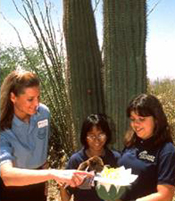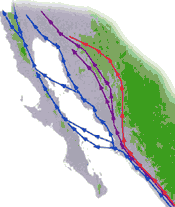Migratory Pollinators Program
INTRODUCTION

|

|

|

|
More than 218,000 of the world’s 250,000 flowering plants, including 80% of the world’s species of food plants, rely on pollinators for reproduction (Emblidge and Schuster 1999, Buchmann and Nabhan 1996). For over a decade, biologists have been concerned about apparent declines in pollinators, especially those that migrate between regions, and the concomitant declines in seed production of flowering plants. This concern over plant-pollinator interactions has contributed to a paradigm shift from protecting individual species to protecting inter-specific relationships and landscape-level ecological processes. While an awareness of these relationships and processes is not new to conservation biology, the recent attention given to these topics by resource managers, policy-makers, environmental educators, and the press has been unprecedented. Former Secretary of the Interior, Bruce Babbitt, urged conservationists to embrace pollination conservation, which benefits many species including humans. The U.S. Departments of Agriculture and Interior have since defined cooperative research and management agendas to address declines in pollinators (Tepedino and Ginsberg 2000). Many other organizations and institutions also have added plant-pollinator interactions to their conservation agenda (Allen-Wardell et al. 1998, Kremen and Ricketts 2000).
In 1995, The Arizona-Sonora Desert Museum (ASDM) launched the Forgotten Pollinators Campaign (FPC), which helped focus international interest on threatened interactions between plants and their pollinators. The FPC brought public attention to the fact that many of the 200 vertebrate and 10,000 or so insect pollinators are now globally at risk. The campaign pointed out that we will likely witness substantial declines in crop yields and diminished survival of keystone plants vital to natural ecosystems unless pollinator conservation efforts move forward quickly and successfully.
In 1998, the FPC was restructured as a multi-institutional, binational Pollinator
Conservation Consortium (PCC). The PCC was formed to strengthen our collaborations
with Bat Conservation International, the University of Arizona, University of
Miami, and several Mexican universities and research organizations (UNAM, UNISON,
IMADES) which have the complementary skills and talents needed to mount a large
scale binational effort. This approach of “Conservation across
Borders” recognizes that these problems cannot be resolved by one sovereign
nation alone, nor by a few isolated scientists.
 In
addition to emphasizing collaborative research efforts, research at the ASDM has
been enhanced with excellent educational and public outreach programs allowing
us to extend our research findings and subsequent conservation awareness to a
broad cross-section of U. S. and Mexican society. Migratory pollinators
travel long distances through areas with varied land uses including both public
and private lands. In order to protect these
migratory corridors, it is crucial to develop local public acceptance of the
conservation needs and opportunities identified by this project. Involvement
of local people in educational programs and in collection of scientific data is
an effective way of opening the door to public embracement of conservation efforts.
This participatory approach allows local people to take control of their own resources
through understanding, information gathering, and subsequent management action.
It is also crucial that pertinent research results reach policy makers so that
migratory corridor conservation practices can be implemented and institutionalized.
In
addition to emphasizing collaborative research efforts, research at the ASDM has
been enhanced with excellent educational and public outreach programs allowing
us to extend our research findings and subsequent conservation awareness to a
broad cross-section of U. S. and Mexican society. Migratory pollinators
travel long distances through areas with varied land uses including both public
and private lands. In order to protect these
migratory corridors, it is crucial to develop local public acceptance of the
conservation needs and opportunities identified by this project. Involvement
of local people in educational programs and in collection of scientific data is
an effective way of opening the door to public embracement of conservation efforts.
This participatory approach allows local people to take control of their own resources
through understanding, information gathering, and subsequent management action.
It is also crucial that pertinent research results reach policy makers so that
migratory corridor conservation practices can be implemented and institutionalized.
 Migratory
Corridors
Migratory
Corridors
While protection of plant/pollinator interactions
is an emerging national priority, ecological conditions of migratory corridors
for pollinators have received far less attention than conditions at wintering
grounds in the south and breeding/birthing grounds in the north. “Nectar
corridors,” a term first used by bat ecologist Ted Fleming (Fleming et al.
1993) specifically for pollinator corridors, are a distinctive type of migratory
corridor comprised of a series of stepping stones placed in a dissimilar matrix.
They are the migratory routes that pollinators follow in order to take advantage
of a sequence of plants coming into bloom along a south-to-north gradient in the
spring and the reverse in the fall.
This sequence of flowering plants provides migrants with sugars, lipids, and amino acids to fuel their long-distance flights. In seeking out this nectar, pollinators incidentally transfer pollen from one plant to another. By doing so, they facilitate genetic mixing, seed set, and reproduction for their floral hosts. When land conversion and fragmentation, toxins, or climatic change weaken one link along the way, the entire chain may be broken. Since the energetic needs of migratory pollinators are highest when they are migrating, any shortage of fuel en route can have devastating consequences.
The nectar corridor that extends from southwestern Mexico north to the Intermountain West of the U.S. and Canada is of particular concern. Lesser long-nosed bats (Leptonycteris curasoae), rufous hummingbirds (Selasphorus rufus), white-winged doves (Zenaida asiatica), and monarch butterflies (Danaus plexippus), as well as many other pollinators, move seasonally along this corridor traveling between the tropics and their northern breeding/birthing grounds. These types of migrations have been termed “endangered natural phenomena.” There is consensus among biologists that many migrant roost sites have already been lost, migratory corridor habitats have been converted or fragmented, invasive plant species are out competing many floral resources upon which these migrants depend, and many of the flowering plants these migrants visit are suffering low seed set due to pollen decline.
We selected the four aforementioned species as focal points for this project. They are important migratory pollinators with very different life history strategies that utilize the west American corridor. As such, they are surrogates for the countless other migratory pollinator species which will survive only if we quickly come to understand their biology and migrations and implement conservation plans. Pollinators are “keystone species,” linking the fate of many other species scattered over large landscapes. Conservation of these species will inevitably benefit overall regional and global biodiversity, and the well-being of humans.
Lesser Long-nosed Bats
Lesser long-nosed bats are federally listed (endangered) for protection in the U.S. and Mexico. These nectar-feeding bats that migrate up the west coast of Mexico depend upon agave and columnar cactus nectar for much of the year, but switch to the nectar of certain tropical trees and shrubs in the fall and winter. These bats are known as “mobile links,” providing pollination services between plant populations over long distances. Lesser long-nosed bats are also “keystone mutualists” as they are the co-evolved partners of ecologically important columnar cacti and agaves in desert and dry tropical habitats. These plants that once dominated much of the arid landscape from central Mexico to Arizona are becoming less available along many sections of the corridor due to urbanization, conversion of native vegetation to agriculture, and the spread of buffelgrass (Pennisetum ciliare) and similar exotics that spread fires that eliminate native cacti, legumes, and agaves.
Lesser long-nosed bats are also vulnerable where they congregate in large numbers at their maternity roosts (Arita and Santos del Prado 1999). Rural residents who have mistaken these bats for vampire bats have burned, dynamited, or otherwise disturbed the roosts. In some areas of rural Mexico, legends of vampires motivate local residents to kill bats. In addition, there are long sections of the nectar corridor through southern Sinaloa, Nayarit, and Jalisco where few roost sites have yet been identified. There is also concern that expansion of tequila production in Jalisco and Nayarit has reduced floral resource availability because blue agaves (Agave vivipara) are seldom allowed to flower in cultivation.
Rufous HummingbirdsAccording to the National Audubon Society’s Watch List, rufous hummingbirds are among the 14% of U.S. breeding avian species for which there are preliminary indications of a unidirectional decline (Calder 1999). Russell et al. (1994) monitored rufous hummingbirds during their migrations and found indications that some of these migrants are resource limited. A high percentage of these hummingbirds are suffering low body weights which necessitates longer stopover times when floral resources are scarce.
In some cases, this scarcity of floral resources may simply be due to temporary drought conditions. However, buffelgrass is devastating low-elevation habitats in Sonora, including the important nectar resource plants for rufous hummingbirds such as tree ocotillo (Fouquieria macdougalii), tree morning glory (Ipomoea arborescens), and chuparrosa (Justicia californica) (Búrquez et al. 1996). Competition from exotic grasses and shrubs may be exacerbating the effects of drought on the floral resources upon which rufous hummingbirds depend during their energy-intensive migration, but how direct and pervasive this competition may be is only beginning to be understood. The ASDM sponsored international conferences on exotic weeds in 2001 and 2002 (Tellman 2002). These conferences are summarizing our understanding of exotics, and their natural history and impact on native flora and fauna in the southwest.
White-winged DovesWhite-winged doves, important game birds in western North America, are often considered seed-eaters and some populations are strictly granivorous. However, the white-winged doves that summer in the Sonoran Desert are important and reliable pollinators of the saguaro (Carnegiea gigantea). These doves winter in southern Sinaloa, Nayarit, and Jalisco, Mexico then synchronize their return to the desert with cactus flowering and their reproduction with saguaro fruit ripening. The Sonoran Desert’s white-winged doves are distinctive enough morphologically (perhaps in part due to their flower-visiting adaptations) to merit subspecific status (Zenaida asiatica mearnsii).
White-winged dove population declines have been dramatic over the last few decades dropping from 700,000 harvested by Arizona hunters in 1968, to 100,000 harvested in 1980 (Martínez del Rio 2001). Presently, the number of doves harvested remains low (Martínez del Rio 2001). Declines in white-winged dove populations have been ascribed to land uses such has groundwater pumping, loss of riparian mesquite forests, land-clearing, and citrus orchard and grain crop abandonment (Martínez del Rio 2001). Our perception of population trends in Arizona may be biased, however, by emphasis on the large and highly variable populations that nested colonially in extensive riparian mesquite bosques and that presumably fed on agricultural products. Desert dwelling, saguaro-dependent populations of white-winged doves have received far less study, and their population trends are not well understood.
Monarch ButterfliesAlthough a monarch conservation agreement was signed by Mexico, the U.S., and Canada in 1996 to protect this “endangered natural phenomenon,” virtually all new conservation efforts resulting from that agreement have focused on the butterfly wintering grounds in Michoacan (Mexico) despite specific wording in the agreement which addressed corridor issues. Some monarchs west of the Rocky Mountains are thought to migrate into Mexico (Brower and Pyle, in press). This is contrary to earlier beliefs that only eastern monarchs migrate into Mexico and western monarchs migrate strictly to the Pacific coast of California. There is now good evidence that at least some western monarch populations migrate west of the Sierra Madre Occidental, Mexico, across the Arizona-Sonora border. However, because these butterflies have not been tracked south of the U.S./Mexico border, their final winter destination remains uncertain (Brower and Pyle, in press).
Ample nectar sources along monarch migratory corridors are crucial for monarch survival in their wintering grounds in the south and breeding grounds in the north. Herbicides, agriculture, and development have reduced nectar availability in many areas leading to monarch starvation along certain portions of the eastern migratory corridors (Brower 1985; Brower and Pyle, in press). Since the monarch migratory route west of the Sierra Madre Occidental was only recently discovered, it has been beyond the scope of this project to identify the exact geography of this corridor. However, extensive public outreach programs are a crucial first step in the preservation of these threatened western monarch migrations.
Status
It is clear that the anthropogenic
stresses faced by migratory pollinators during their annual migrations are substantial
and increasing, even though many details are not well understood. These
migrants are particularly vulnerable during long migrations across arid lands,
especially when their stopover sites are impacted by land use changes. In
order to determine the “weak links” along these corridors and subsequently
formulate conservation strategies, it is necessary to identify the locations of
nectar corridors, understand migratory pollinator biology, and determine the status
of floral resources. Binational education outreach is also crucial to the
long-term success of conservation efforts.